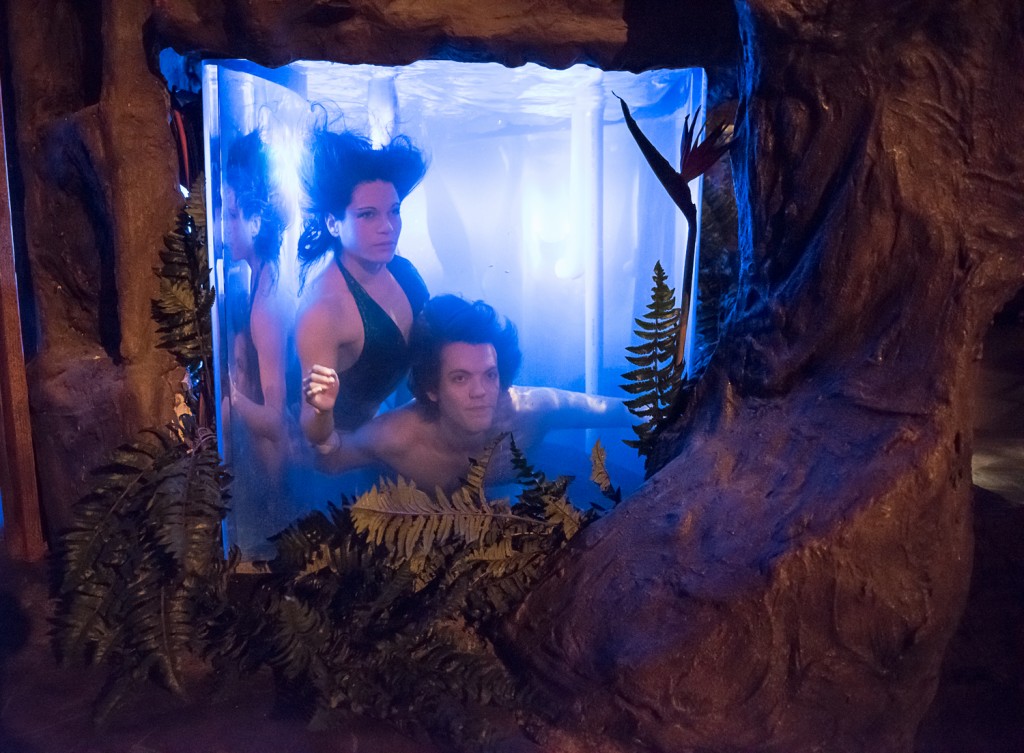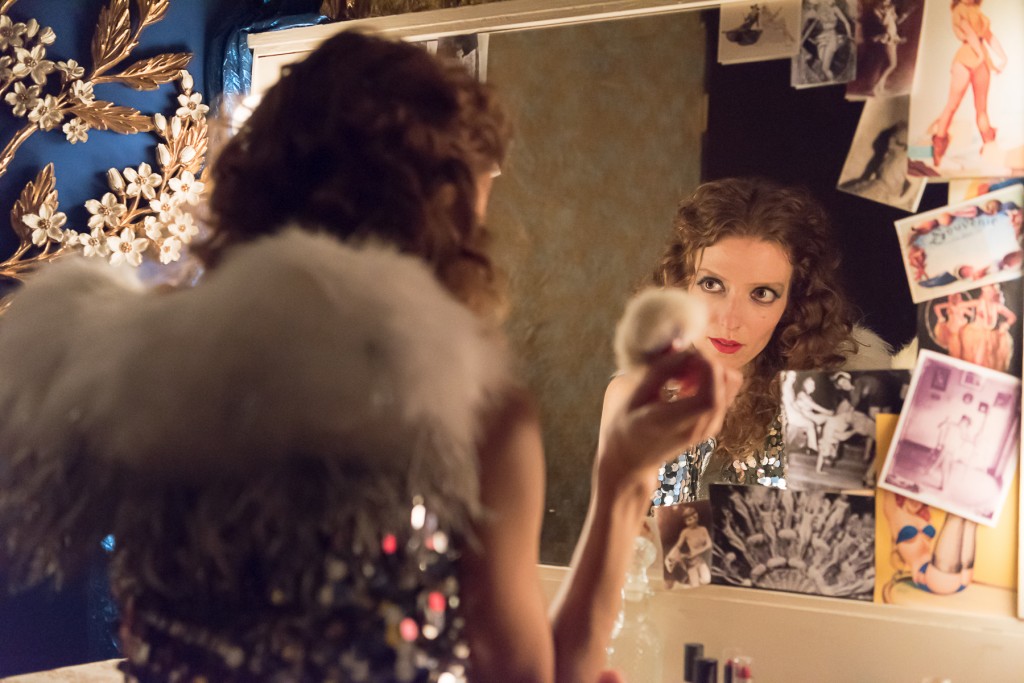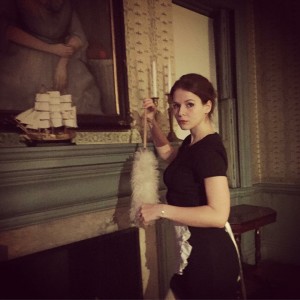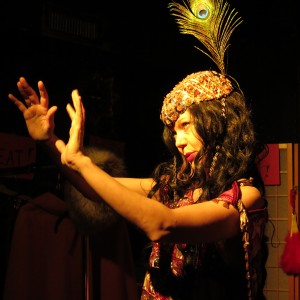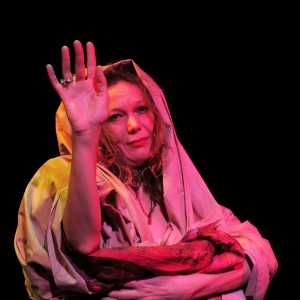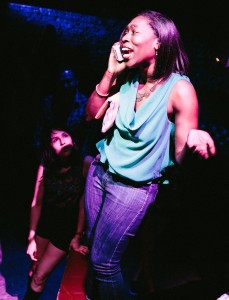You may remember Soho Playhouse before the pandemic. Located in an antebellum row house just off Sixth Avenue, it often featured solo and Fringe Festival plays in its careworn mainstage theater or cabaret downstairs, its stairwell adorned with framed posters of shows that had played there.
Novenas for a Lost Hospital
Novenas for a Lost Hospital is a memory play told through several narrators that celebrates St. Vincent’s Hospital, a Catholic charitable hospital in the West Village that was founded in 1849 and closed in 2010. The novenas (devotional prayers in Catholicism), of which there are nine, give structure to the elegant sections that move back and forth in time from the founding to the closing. The effect is part drama, part history lesson, and part activism/immersive theater.
The Hidden Ones
During the Holocaust, the atrocities of the Nazi regime forced countless Jewish families and individuals into hiding. Though they were not interned in concentration camps, these stowaways were subjected to another, silent, reign of terror—in which every creak and cough could result in discovery, detainment, and almost certain death. Thus, the scene is set for The Hidden Ones, an immersive theater production that brings audiences into the secret hiding place of two families at the end of World War II
This Is When We Rest
An asteroid collides with Earth in just over an hour. You are at an apartment party in New York City with eight people whom you know from various stages of your life. What do you discuss with them? What is going through your mind? Do you have any regrets? These are the large, existential questions brought forth by Part Two of Live In Theatre’s This Is When We Rest, an apocalyptic theater experience designed by Leland Masek that combines Live Action Role Play (LARP) gaming and participatory theater.
A Warm Welcome to Paradise
Third Rail Projects wastes no time in sweeping their audiences off the dirty streets of Bushwick and into the fold of their latest immersive world, The Grand Paradise. There are no tickets to The Grand Paradise, only boarding passes, and you’ll receive yours after checking in at the departures gate of their retro-fantasy airline. After a brief “in-flight” video on resort rules, you’ll disembark into the warm, indulgent terrace of the Grand Paradise resort. Crowded with sexy, sultry residents, the space is bedecked in tiki paraphernalia—fake palms, beaded curtains and a giant aquarium (indeed, every detail of the production design smacks of the culturally confused late 70s). It’s not long until you’re greeted by the swoon-worthy Siren (Elizabeth Carena) and your immersive adventure at The Grand Paradise begins.
Following their wildly popular show Then She Fell, artistic directors of Third Rail Projects (Zach Morris, Tom Pearson and Jennine Willett) have expanded their audience size and added elements of spectacle to their latest production. Yet despite the added glitz, Third Rail Projects still manages to afford all audience members the intimate moments that make this type of theater so thrilling. Certainly, not everyone is comfortable with audience participation, but Third Rail Projects has made audience involvement feel as fun and safe as possible. Around every corner of The Grand Paradise is an inviting situation that directly involves audience members (individually or in small groups). The best part about the immersive design of The Grand Paradise is that participants need only watch and listen, and they will be warmly invited into a wide variety of charming and thought-provoking situations. Audiences are instructed not to open closed doors, and there is no need to chase characters, or elbow to the front for a good view, which—for viewers like myself—is a frustrating aspect of popular participatory productions today.
The Grand Paradise keeps audiences entertained during their entire two-hour stay and, indeed, the ensemble cast is a veritable treasure trove of diverse talent. Each performer adds something unique to your experience, whether it be pondering the passage of time with the elusive Venus (Emma Hoette), topographically mapping your past and future decisions with the activities director (Alberto Denis), trashing hotel rooms with the mischievous Jett (Mayte Natalio), or tying nautical knots while at sea with the Libertine (Bryan Strimple). The truly outstanding moments of The Grand Paradise are when the theatrical experience conjoins itself with your own life—beckoning the contemplation of more universal themes of time, fate, love and loss.
Like many immersive companies practicing in New York (Punchdrunk and Journey Lab), Third Rail Projects incorporates a good deal of contact improvisation dance into their experiences. While this style of post-modern dance is beautiful, and physically demonstrates meaningful tension and release between characters, it has become rote for many immersive performance makers. There are moments when these sequences linger for too long, losing significance and becoming somewhat monotonous. Within the marvelous bigger picture of The Grand Paradise, the slightly lengthy improvisational dance scenes are a forgettable flaw.
Whether you are an amateur or seasoned immersive theater-goer, there is something for you at The Grand Paradise. The cohesive theme, remarkable talent and complex-yet-invisible immersive design make for a fun and refreshingly unique experience. While many immersive shows deconstruct existing pieces of literature such as Alice and Wonderland or MacBeth, The Grand Paradise creates a fascinating world of its own to which no parallel exists. Hold your breath and dive into Third Rail's The Grand Paradise.
The Grand Paradise plays in Brooklyn at 383 Troutman St. (between Irving and Wyckoff Aves.) through Sept.4. Must be 21 or older to attend. Wear comfortable shoes and clothing with pockets. Ticket prices vary and are available at http://thegrandparadise.com/tickets.
Immersed in Ibsen
“Be careful whom you trust,” a maid whispers warningly into my ear as she swishes past me up a dark stairwell. This servant (played convincingly by Macy Idzakovich) is one of many peripheral characters haunting the halls of the historic Morris-Jumel Mansion in Journey Lab and Deaths Head Theatrical's The Alving Estate—an immersive staging of Henrik Ibsen’s Ghosts. Indeed, ghosts are central to Ibsen’s body of work and this particular production, which explore the foibles of the living, as well as the hauntings of the familial past. Though The Alving Estate experience is not without its aesthetic shortcomings, it succeeds in convincing audiences that there are deep secrets hidden within the walls of this eerie mansion.
As my experience with Idzakovich as the maid demonstrates, the participatory nature of Journey Lab's aesthetic infuses Ibsen’s oeuvre with extra sex and intrigue. Journey Lab’s take on Ghosts, like many immersive works today, puts the audience at the center of the experience, giving participants the opportunity to choose where to go (and who to follow) within the mansion. This production choice comes at the expense of narrative cohesion, so if you’re looking for something more experiential than narrative, this is your type of production; on the other hand, if you’re interested in piecing together a storyline, you should read or familiarize yourself with Ibsen’s play before indulging in The Alving Estate.
Upon arriving to the mansion, you are given a job description and prepped for an interview for employment at the estate. After socializing over drinks with other “applicants” in the charming and dimly lit carriage house, audience members are selected at random to begin exploring the mansion. The Morris-Jumel Mansion is itself a star character in this production; its creaks, draughts, and creepy oil portraits all add unique charm and mystique to the experience. Unfortunately, there are some informational plaques visible in parts of the mansion, which distract from the time and place of the immersive experience.
While the site of this performance provides a delightful opportunity to explore an old gem of upper Manhattan, there are other aspects of this production that are less unique. Journey Lab takes a great deal of cues from British immersive theater pioneers Punchdrunk and their long running production Sleep No More, which has been running in Chelsea since 2011. The resemblances between this production and the Punchdrunk aesthetic may distract audience members familiar with the Sleep No More empire. Eerie music, intense moments of eye contact with the actors, and choreography reminiscent of contact improvisation are all pulled directly from the existing repertoire. Even some of the costumes and props—backless ball gowns, old photographs, costume jewelry—seem to be hand-me-downs from The Alving Estate’s immersive predecessor.
Though The Alving Estate is haunted by an existing aesthetic, it still manages to showcase the raw talent and latent creativity of Journey Lab, an immersive company to look out for in the future. Surely, Punchdrunk provides a worthy aesthetic role model for aspiring immersive theater makers, but I suspect that the talent at Journey Lab could—and should—move beyond this copycat approach to become innovators in this exciting contemporary form.
The Alving Estate runs Thursday through Saturday at 7 p.m. until Feb. 6 at the Morris-Jumel Mansion (65 Jumel Terrace) in Washington Heights. Tickets range from $20-$50 and can be purchased by calling or visiting http://journeylab.org/experiences/.
Disasters Change People
Audience participation in Take Care consists of three levels—featured participants, group participants and voyeurs. Featured participants give solo performances, group participants perform with three or more people and voyeurs pretty much just watch. Participants are given instructions with a starting time, starting location, action, ending time and what to do when done. There are six to eight prompts that are to be performed within 50 minutes and the prompts usually involve making sounds, reciting lines and/or moving body parts. On the walls are television screens and digital clocks that count down the time and act as timers. During the performance, anyone—even the voyeurs—can go up to the microphone and pause the performance by saying “hold.” The clock stops and the person holding up the show can share their critique, comments, suggestions or requests about the production and the actors will respond. There is only one “hold” available for the whole performance.
All theatergoers receive personalized customer service from the moment they drop off their coats at the coat check to being escorted downstairs to their seats. Each point of contact provides theatergoers the opportunity to engage with the production before the performances even start. The actors offer the audience members mints and ask, “What is your desired level of participation?” No matter what level of participation a person chooses, the production provides a space for theatergoers to explore how they respond to emergencies and dangerous environments while in group situations.
The Flea Theater’s artistic director, Niegel Smith, partnered with his long-time collaborator, Todd Shalom, to create Take Care. Smith also directs The Flea Theater’s resident volunteer acting company, The Bats, in this production. At times, the actors feel more like supportive audience members or coaches guiding the participants through their scenes. Some of the most memorable, authentic and telling moments happen when the theatergoers share their personal stories at the microphone. For example, one woman shared about being discriminated against at the DoubleTree Hotel in Jersey City during Hurricane Sandy because she was black. Another woman, who had left Singapore because of religious persecution, was confronted with her past when a Singapore news channel wanted to interview her during Hurricane Sandy because she was Singaporean. A bartender talked about spending his time at work in Manhattan donating candles to people during Hurricane Sandy. Later, participants ask their neighbors if they can put their head in their lap or on their shoulder and then everyone watches a video of people kissing each other.
The value of the production is in the range of human emotions that are evoked and experienced by the theatergoers. Climate change, natural disasters, environmentalism, racism and many other subjects are covered throughout the show, but the topics go deeper than just being thought-provoking. Audience members feel alone and isolated within the group and then loving and comforting toward each other. The events have theatergoers distinguish their own resistance to helping fellow survivors. Take Care creates a dual experience where theatergoers feel like “we’re all in this together,” while at the same time, audience members go through their own personal journeys.
The material is relevant to the modern world and reads like it was more likely inspired by Hurricane Katrina than Hurricane Sandy. The production is effective enough as a fluent expression and does not get bogged down with the subject matter. Instead, the theatergoing experiences are personalized. If the overall aim and vision were to see if people really do take care of each other, then playwright and director Smith has achieved this. The play leaves theatergoers in a different place than where they started off.
The challenge with this production is its ability to travel outside of New York City and for theatergoers in other markets to relate. A greater balance between the positive and negative events that take place would make the uplifting scenes occur more natural and less out of place. More live singing and dancing could maximize the performances.
Take Care is recommended for theatergoers who do not mind getting a little wet and who are seeking something different. It is a participatory performance with a cast that really does care about its audience members. It is not recommended for those seeking a traditional theatergoing experience that involves passively observing. The production will likely trigger past events and transform how people relate to each other during a major disaster. It is also a production that theatergoers could experience every night of the week and never experience the same show twice since the participants are always different. Each participant alters the mood of the performance with his or her sharing. The next natural disaster that happens will likely share some of the same emotional elements that are exposed in Take Care.
Take Care runs until Jan. 25 at The Flea Theater (41 White St. between Church St. and Broadway) in Manhattan. Evening performances are Monday at 7 p.m. and Thursday-Saturday at 9 p.m. with no matinee performances. Tickets range from $15-$35. To purchase tickets, call 212-352-3101 or visit TheFlea.org.
Love is a Dangerous Game
The small stage where Almost Mata Hari: Lovers, Letters and Killers by Eva Dorrepaal which explores the life of Mata Hari, the infamous courtesan-cum-spy, as well as parallels to the dangerous loves in her own life, is tucked away in the basement of Theater for the New City. This venue has many theaters; two are in the basement on opposite sides of the building. But the spectator is rewarded with the discovery of finding the right door. And descending the dark staircase is the perfect entrée to Dorrepaal’s world. Set as a living room, it looks as if it will explode with one false move: clothing and bric-a-brac are strewn everywhere. Short directives such as “Breathe” are pasted everywhere, as are Dorrepaal’s notes about Mata Hari: a timeline of her life and lists of men. The feeling is potentially claustrophobic and one wonders if Dorrepaal has been reading up on the avant-garde theater provocateur, Antonin Artaud’s concept of a “Theatre of Cruelty” which called for the "communion between actor and audience in a magic exorcism (…) to shock the spectator into seeing the baseness of his world.” Artaud was known to stage plays or scenes in isolated places where, one person who attended an Artaud play in the '60s, claims, “there could have been a murder and no one would have known.”
Dorrepaal appears debased at first—her clothing is disheveled, and she is harried and seemingly uncomfortable. She recalls an early abusive relationship: a broken jaw leads her to a dentist whom she eventually takes up a relationship with. Dorrepaal’s play begins in an emotionally Artaudian vein: two hours of listening to stories about violent relationships would have definitely felt entrapping and scary. She briskly changes pace and shifts the focus.
As an actress, Dorrepaal is fidgety, breathless and wide-eyed, which gives the impression of a woman on the verge of a nervous breakdown. However, there are interesting angles being worked which reveal three distinct layers: how an actress prepares (Dorrepaal refers to the method acting approach of using sense memory), her personal stories about past lovers, and her response as both an actress and woman to the story of Mata Hari’s life. The premise of Dorrepaal’s show is that she is an actress writing a play about Mata Hari. However, Dorrepaal inserts herself into the performance, and comments on the difficulty of acting, as well as the role of Mata Hari. Under the guide of a less gifted actress, this triadic approach could have been confusing, but Dorrepaal is a masterful performer. And funny too. In one scene, Dorrepaal is playing Mata Hari as a dancer and courtesan. She changes in front of us and puts on an Indian dance costume, with a spangly bra and a full skirt. As Mata Hari she’s dancing, but after awhile Dorrepaal, the woman, gets fed up and screams: “She’s so crazy” (about Mata Hari) and “Fuck, I’m going to have to hire a choreographer” (about herself as a performer). There are many more moments like this that lift the show from a purgatory exploration of women’s abusive relationships to a true exploration of the complexity of being a woman, of love and of being an actress.
Dorrepaal brings to light the dangerous nature of love. Mata Hari had many lovers—particularly military men in high commanding positions—and was rewarded richly with money and goods. She was known to be a spy but no one knew whether she did it for the money or because she could. In the end, she was convicted to death by a firing squad for being a spy; supposedly betrayed by one of her lovers. Dorrepaal informs us that “she died like a man” because she refused a blindfold. Dorrepaal also experienced dangerous love, first with the man in her early years who broke her jaw, and then with Dragan Zabek, an “irresistible mystic who worked as a street performer.” Dorrepaal leaves Holland, her native land, when she wins a green card only to learn that Dragan killed his former girlfriend—viciously strangling her and dragging her from one place to another—and then hung himself in prison.
Dorrepaal is an intriguing actress. She is tall and thin and looks like she has lived life. Her natural hair, which is a wiry reddish brown, often behaves like the wig she dons when she portrays Mata Hari. When she flips it over to one side, it stays there. Other times, it flairs around her face, making her look angry or seductive depending on the angle. Dorrepaal is a shape-shifter as a performer.
In another actor, this could prove frustrating or make her seem uncommitted to her role, but in Dorrepaal, we see a range of emotion pass across her face in a small time span. Sometimes she looks beautiful, other times tormented. This shape-shifting of emotion seems more true to life in the face of dangerous love, which heightens the senses so that desire, fear and uncertainty exist simultaneously.
Almost Mata Hari: Lovers, Letters and Killers, written and performed by Eva Dorrepaal, runs until Jan. 24 at Theater for the New City (155 First Ave. between East 9th and 10th Sts.). Performances are Thursday-Saturday at 8 p.m. and Sunday at 3 p.m. Tickets are $10 and can be purchased by calling the box office at 212-254-1109 or visiting www.theaterforthenewcity.net.
Down the Rabbit Hole
Third Rail Projects has a rich production history of placing its audiences on the cusp of collaborative theater. Its dancer-actors are the clicking wheels of a larger machine; they are not themselves the stars of the show, but let an almost spiritual illusion take over that billing. In the long-running hit Then She Fell, experiential theater transcends all of its normal bounds to create just that illusion. The production, which is written, directed, designed and choreographed by Zach Morris, Tom Pearson and Jennine Willett, is a haunting take on Lewis Carroll's book "Through the Looking-Glass," and it derives every last morsel of dark lyricism from its source material.
Surrounded by Aching Hearts
Dating in New York City has often been represented in situation and romantic comedies, from On the Town to First Date the Musical, and on TV shows like Sex and the City. In fact, the neuroses and eccentricities of New York singles have provided inexhaustible fodder for playwrights and screenwriters.
Add to this mix director Michael Counts’s immersive theater experience, Play/Date, a collection of 22 one-act plays about the dating scene in the Big Apple. The plays—which stage hookups, breakups, and everything in between—take place simultaneously in an actual nightclub, Fat Baby, on the Lower East Side. This production’s greatest strengths lie in its design: the stimulating lighting by Ryan O'Gara and Marcello Añez’s sexy soundtrack, along with Counts’s staging, create an experience that surrounds the audience. The production’s weakness, however, is an overall inability to convey many honest or original messages about the trials and tribulations of dating in New York City.
Just as any other night at Fat Baby, audience members must wait behind velvet ropes before entering Play/Date. Though the interior of the club is emptier than it would be on a regular night, the rave lights are on, and the bar is open. But the bar is only one of the spaces where these solo and small-cast one-acts take place: various concurrent scenes take place at the tables upstairs, on the dance floor, and in dark enclaves around the club. There is even a series of projections, in which the texts of a character on a cellphone are displayed on the wall behind them.
For the most part, the simultaneity and technique of the short plays are managed impressively well, though there are some moments when it is hard to hear performers. As with many immersive productions, audience members are generally able to roam about and watch any scenario they like; these free-form periods are interspersed with moments when the action comes together in choreographed spectacle. As the plays progress, characters and audience become progressively drunker—for the performers, this means the usual fights, along with regrettable phone calls and lurid meet-ups in bathroom stalls. Because of these simultaneous storylines, one will find it impossible to see everything that Play/Date has to offer in just one visit.
While the physical space of the nightclub is thrilling to explore, and the ensemble is talented and committed, the plays that I encountered do not really say anything new or different about New York City dating. Overall, they mostly redistribute the tired narratives that are already prevalent in television, movies, and theater. Many of the plays overreach in their commentary on technology and its insipid ubiquity through dating websites, social media, and smartphones.
Although there are some unexpected moments involving hand puppets, alien conspiracy, and a random shirtless woman, they are overshadowed by the production's sexiness, reading ultimately as trite rather than meaningful. Overall, there is something more generous to be said about dating in this crazy city, something that these plays are too short and too scattered to capture. Play/Date is worth seeing for its production elements and site-specific location, but do not expect to walk away with an especially nuanced understanding of the New York City dating experience.
Show times for Play/Date are Sunday through Wednesday at 8 p.m. at Fat Baby (112 Rivington St., between Essex and Ludlow streets, on the Lower East Side). Tickets start at $55 for general admission; reserved tables are $75. The new $95 "Friends with Benefits" ticket option includes reserved priority table seating with waiter service, plus an opportunity to fully interact with the performers in specially created scenes that take place at the table. Tickets are available by calling Ovationtix at 866-811-4111 or visiting www.playdateny.com.
New York Horror Stories
In their 11th year of scaring the residents and tourists of New York City, producers Timothy Haskell (creator of Nightmare) and Steve Kopelman (producer of Rob Zombie’s Great American Nightmare) have once again devised an unforgettable haunted house, with the theme Nightmare: New York.










